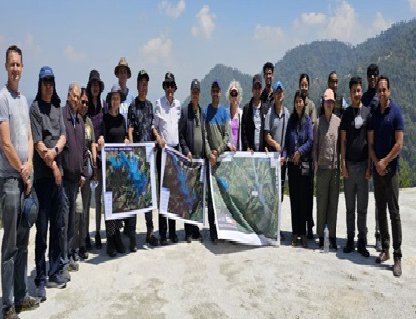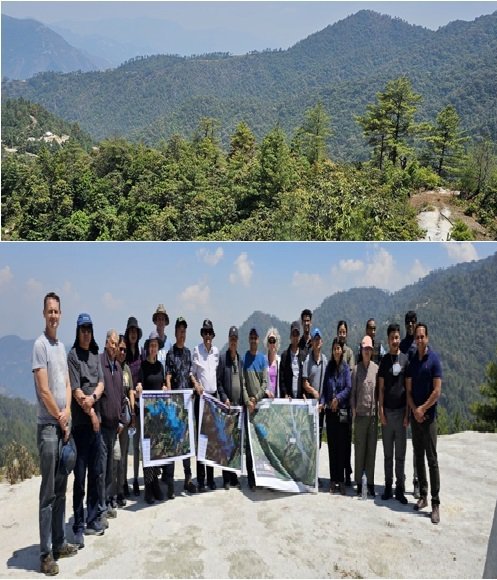
The last time I attended a workshop that was truly “paradigm shifting” was the May 1986 Mohonk Mountain Conference. It debunked the “Theory of Himalayan Degradation” which, to crudely summarize, asserted that poor and fecund Nepali farmers cutting trees and deforesting Nepal contributed to flooding in Bangladesh. Not only has Nepal not been denuded bald of all forests by the year 2000 as it predicted: today we have more forest cover than ever in our recent history thanks to innovations like community forestry. Exactly 37 years later, it was my good fortune to visit field sites and attend workshops in Sikkim, Bhutan and Nepal regarding Pump Storage Hydro (PSH) with colleagues from there as well as the Australian National University (ANU), and was similarly conceptually challenged.

The principle behind PSH is very simple and it has been used in Europe since a hundred years back: you pump water from a lower water body (a lake or a river) to a pond at a higher altitude when electricity is throwaway cheap during off-peak night time and send the water back to drive a turbine and produce electricity during peak hours when most needed. The difference in peak and off-peak price of electricity is more than able to offset the efficiency loss incurred in pumping water uphill. Conventional hydro development is about building a dam across a river and sending the water to turn a turbine at the toe of the dam or via a tunnel further down the river to take advantage of the bigger height difference (head). PSH in contrast often does not even require damming a river: a sump on the side of a river bank or an existing pond/lake does the trick. One just has to fine an appropriate site for a small pond on a nearby hill to collect the water pumped uphill; and the higher the hill site is, the smaller is the pond – and much less the socio-environmental impact – required as power produced is a product of head and water flow, the higher head requiring much less flow to produce the same amount of power.
There is renewed interest in PSH primarily due to the fact that globally the cost of solar photo-voltaic (PV) power has decreased dramatically. In 2010, PV produced electricity cost 40¢/kWh but today the global average is 5¢/kWh, about the same as, or slightly lower than, conventional hydropower. India’s energy think tank TERI estimates that in India the cost can come down to as low as 2.5¢/kWh by 2030 (or half of what hydro will cost!). Given that solar panels have no moving parts, once installed, their maintenance cost compared to conventional hydro is near zero (requires only washing the panels every now and then of the accumulated dust). US Energy Information Administration estimates that capital “overnight” costs (as if no interest was incurred during construction) per Watt is lowest for solar PV, three times more than that for conventional hydro and six times more for coal with 90% carbon capture. Add climate change concerns,which is forcing economies worldwide to de-carbonize their power systems in favour of renewable energy, and both solar PV as well as hydro (and more specifically PSH) are experiencing a renaissance in increased attention.
There is, however, a major catch for solar PV: though Nepal, like much of tropical semi-arid South Asia is blessed with ample sunlight unlike countries in the northern latitudes, it is available only for some eight hours a day. This means some form of storage is required for the remaining 16 hours. Batteries are expensive and can handle only the requirements of limited number of households or small factories. For grid-level storage, only PSH can currently provide the required large volume of energystocking. Thus, a program of solar PV expansion has to go in tandem with PSH development as the grid system’s “battery”. Approached this way, solar PV does not displace conventional hydro but rather provides for its more efficient exploitation by using developed and established skills of civil and electro-mechanical engineering in the hydro sector as a powerful complement, thus reducing potential political backlash.
ANU has prepared, based on remote sensing data, a global atlas that identifies over 600 thousand potential sites worldwide, in Nepal alone several thousand. As a research effort undergoing constant improvement, it was felt that some ground-truthing was needed, hence the recent fieldwork and workshops in Sikkim, Bhutan and Nepal. The first insights to emerge was that, unlike in Australia which is mostly dry and flat except in its eastern fringes, height availability is not an issue at all in the Himalaya: it comes in any shape and size and numbers desired. This immediately means two things: first, we can immediately go for the cheapest option of simple penstocks avoiding expensive tunnelling thus generating very cheap peak electricity; and second, the number of potential sites thus balloons towards infinity! Any reservoir or pondage site on a Himalayan river is surrounded by many high hills which should theoretically provide any number of potential upstream PSH ponds. Geology, land tenure and many other screening issues would ultimately filter out many but still leave a significant number to be considered.
The second insight to emerge was the multiple benefits that could be had from small upper ponds that could also provide besides peak electricity: drinking water to hilltop villages, some small-scale irrigation, and – as the local-level public consultations in Bhutan showed – tremendous help in fighting forest fires! It is well known that one big obstacle to hydropower development has been the very negative role of forest departments that are loathe to allow hydropower developers any permission to cut trees. The possibility of being a help to fight forest fires, as well as other local benefits, would mean a much easier buy-in of concerned interested parties than for conventional hydro.
The third and most important insight in the case of the Himalaya is PSH pointing to the possibility of developing existing and planned hydropower projects anew to get more Mega Watts from the same amount of water. The case of Kulekhani PSH identified by the ANU atlas was very instructive. While NEA is planning a lower reservoir at Sisneri and using the existing Kulekhani reservoir as an upper one, the ANU atlas identified another alternative possibility of using the existing reservoir as the lower one and discovered a small 14-27ha pond some 470m above on the western hill near Simbhanjyang that would allow a 265MW PSH with 6 hours of storage time. The challenge this poses is this: ignoring KL-2 and KL-3 downstream for the while, would you use the reservoir water in the conventional hydro fashion to produce 60MW from the powerhouse below the dam or would you rather use the same water to generate 265MW WITHOUT “losing” the water downstream. (In this PSH case, the water just goes from the lower to the upper reservoir and returns back without being lost to the lower reservoir as is the case in conventional hydro.)
This is a challenge not just for existing Kulekhani HEP but also for other existing and planned hydropower dams. Would you develop the proposed Budhi Gandaki or West Seti multipurpose seasonal storage reservoir project to generate say 600MW at the toe of the dam and lose the water from the reservoir, or would you develop it with PSH in higher mountains surrounding the reservoir generating two or even three times more MWs without losing the water from the reservoir? The answer is obvious and requires a revamping of all hydropower planning. This applies even more to the over one-hundred Nepali private sector hydro developers: since you already have sunk investments in your existing power plants, would it not be beneficial for you to get much more MWs out of those schemes by developing PSH in surrounding hills above your current dam sites and power houses, all at much, much lower costs than building new equivalent sized conventional hydropower plants?
Although the concept is very attractive, there are many challenges up ahead, not the least in revamping Nepal government’s hydropower and energy policies to take advantage of this new for Nepal technology. It will also require a reform of the existing buy-back tariffs to give space to off-peak rates. Meanwhile, given how the price of solar PV is plummeting down, it makes a lot of sense to merge PSH with solar PV, installing the panels floating on lakes or in otherwise wasted land around power plants. And given how both India and China are going full steam with solar PV, India government even relaxing many of its rules to promote PSH to balance the solar expansion, Nepali developers can look forward to their own PSH becoming even more valuable for electricity exchange with our neighbours. Nepal will then be exporting not water but its heights, of which it has plenty!

Dipak Gyawali
Gyawali is Pragya (Academician) of the Nepal Academy of Science and Technology (NAST) and former minister of water resources.
- West’s Electoral Turmoil: Implications For Emerging New World Order
- Jul 14, 2024
- Did Modi Lose Even When Winning?
- Jun 12, 2024
- As You Step Out Into The Real Wide World Of New Challenges…
- May 23, 2024
- Unfolding International Disorder & What It Portends For Small Countries
- May 08, 2024
- Maldevelopment And Technology: Ethos Harbingering Coming Apocalypse
- Apr 03, 2024
















